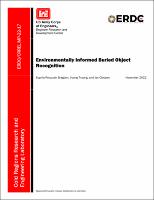Please use this identifier to cite or link to this item:
https://hdl.handle.net/11681/45902| Title: | Environmentally informed buried object recognition |
| Authors: | Bragdon, Sophia N. Truong, Vuong H. Clausen, Jay L. |
| Keywords: | Buried object detection Machine learning Thermal imaging Environmental phenomenology Deep learning LWIR |
| Publisher: | Engineer Research and Development Center (U.S.) |
| Series/Report no.: | Miscellaneous Paper (Engineer Research and Development Center (U.S.)) ; no. ERDC/CRREL MP-22-17 |
| Is Version Of: | Bragdon, Sophia Potoczak, Vuong H. Truong, and Jay L. Clausen. "Environmentally informed buried object recognition." In Chemical, Biological, Radiological, Nuclear, and Explosives (CBRNE) Sensing XXIII, vol. 12116, pp. 304-316. SPIE, 2022. https://doi.org/10.1117/12.2616583 |
| Abstract: | The ability to detect and classify buried objects using thermal infrared imaging is affected by the environmental conditions at the time of imaging, which leads to an inconsistent probability of detection. For example, periods of dense overcast or recent precipitation events result in the suppression of the soil temperature difference between the buried object and soil, thus preventing detection. This work introduces an environmentally informed framework to reduce the false alarm rate in the classification of regions of interest (ROIs) in thermal IR images containing buried objects. Using a dataset that consists of thermal images containing buried objects paired with the corresponding environmental and meteorological conditions, we employ a machine learning approach to determine which environmental conditions are the most impactful on the visibility of the buried objects. We find the key environmental conditions include incoming shortwave solar radiation, soil volumetric water content, and average air temperature. For each image, ROIs are computed using a computer vision approach and these ROIs are coupled with the most important environmental conditions to form the input for the classification algorithm. The environmentally informed classification algorithm produces a decision on whether the ROI contains a buried object by simultaneously learning on the ROIs with a classification neural network and on the environmental data using a tabular neural network. On a given set of ROIs, we have shown that the environmentally informed classification approach improves the detection of buried objects within the ROIs. |
| Description: | Miscellaneous Paper |
| Gov't Doc #: | ERDC/CRREL MP-22-17 |
| Rights: | Approved for Public Release; Distribution is Unlimited |
| URI: | https://hdl.handle.net/11681/45902 http://dx.doi.org/10.21079/11681/45902 |
| Appears in Collections: | Miscellaneous Paper |
Files in This Item:
| File | Description | Size | Format | |
|---|---|---|---|---|
| ERDC-CRREL MP-22-17.pdf | 1.34 MB | Adobe PDF |  View/Open |